Comprehensive Insights into Liver Cancer Pathophysiology
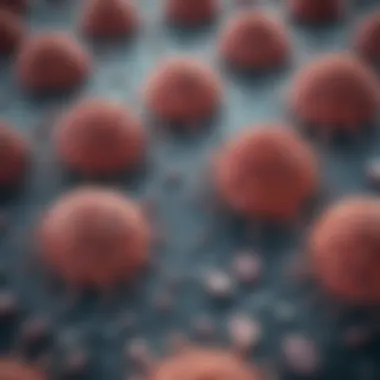

Intro
Liver cancer is a significant global health problem, affecting thousands of people every year. Its complexity arises from various factors including its types, risk factors, and the diverse methodologies used for diagnosis and treatment. This article will distinctly present the pathophysiology of liver cancer, focusing on hepatocellular carcinoma and cholangiocarcinoma. It will explore the intricacies of this disease, thereby providing a detailed understanding crucial for students, researchers, educators, and professionals.
Article Overview
Purpose of the Article
The aim of this article is to offer comprehensive insights into liver cancer. We will break down the disease into understandable components, covering its molecular basis, imaging techniques, and treatment strategies. A thorough understanding of these elements enables healthcare professionals to devise better treatment plans and improve patient outcomes.
Relevance to Multiple Disciplines
The discussion of liver cancer extends beyond oncology. It touches upon several fields such as molecular biology, pathology, radiology, and surgical techniques. By exploring the intersection of these disciplines, this article invites a more cohesive understanding of liver cancer.
Research Background
Historical Context
Liver cancer has witnessed a substantial transformation in diagnostic methods and treatment strategies over the years. The increasing prevalence of hepatitis B and C infections has significantly impacted the liver cancer statistics. Understanding the historical context helps to bridge the gap between past and present knowledge.
Key Concepts and Definitions
To comprehend the complexities of liver cancer, it’s essential to define specific terms:
- Hepatocellular carcinoma: The most common type of primary liver cancer.
- Cholangiocarcinoma: A rare cancer affecting the bile ducts.
- Pathophysiology: The functional changes associated with the disease.
- Epidemiology: The study of the incidence and distribution of the disease.
These concepts form the backbone for analyzing liver cancer's implications in modern medicine, guiding clinicians towards precise approaches for diagnosis and treatment.
"Understanding liver cancer requires more than a superficial examination; it demands an appreciation of its multifaceted nature."
"Understanding liver cancer requires more than a superficial examination; it demands an appreciation of its multifaceted nature."
The exploration of liver cancer is essential, as it informs clinical practices and advances research initiatives aimed at combating this challenging disease.
Foreword to Liver Cancer
Liver cancer represents a significant health challenge globally, affecting millions of individuals each year. This article aims to provide an extensive overview of liver cancer, focusing on its pathophysiology, diagnostic methods, and various treatment strategies. Understanding liver cancer is crucial due to its complexity and the increasing incidence in certain populations. The liver serves vital functions, and any malignancy arising within this organ impacts both health and quality of life profoundly.
Definition and Classification
Liver cancer primarily refers to malignancies that originate in the liver tissue. The most prevalent type is Hepatocellular Carcinoma (HCC), which accounts for approximately 75% of all liver cancer cases. Another notable type is Cholangiocarcinoma, which arises from the bile ducts. Additionally, secondary liver tumors occur when cancer spreads from other organs, like the colon or breast.
Each type of liver cancer has distinctive characteristics, including rate of progression, symptoms, and response to treatments. Understanding these classifications enables healthcare professionals to tailor strategies for early detection and intervention effectively.
Epidemiology and Prevalence
The epidemiology of liver cancer reveals important trends. Globally, liver cancer is the sixth most common cancer and the fourth leading cause of cancer-related deaths. Variations exist by region; for example, higher rates are seen in East Asia and sub-Saharan Africa, largely linked to chronic viral hepatitis infections and aflatoxin exposure.
In the United States, the incidence has increased over the past few decades, driven by rising rates of Hepatitis C and Non-Alcoholic Fatty Liver Disease (NAFLD).
Factors such as age, gender, and underlying liver disease significantly influence prevalence. Men are nearly three times more likely to develop liver cancer than women. Knowing the demographics and patterns of liver cancer helps in creating targeted public health strategies and interventions.
Types of Liver Cancer
Understanding the types of liver cancer is crucial as it shapes both the diagnosis and treatment approaches. Liver cancer primarily includes hepatocellular carcinoma, cholangiocarcinoma, and secondary liver tumors. Each type arises from different cells within the liver and carries distinct biological behavior as well as response to therapies. Recognizing these differences facilitates better management strategies and allows healthcare professionals to tailor treatments effectively.
Hepatocellular Carcinoma (HCC)
Hepatocellular carcinoma is the most common form of liver cancer, accounting for approximately 75% of cases. Patients often exhibit a background of chronic liver disease, such as hepatitis B or C virus infections, or cirrhosis. Early detection of HCC can be challenging, as it can remain asymptomatic in initial stages. More advanced disease may present symptoms including weight loss, abdominal pain, and jaundice.
In terms of management, various treatment options exist. Surgical resection or liver transplantation is standard in appropriate candidates. For non-resectable cases, medical therapies like sorafenib have gained acceptance. It is essential to engage in regular surveillance for high-risk populations to improve outcomes significantly.
Cholangiocarcinoma
Cholangiocarcinoma, or bile duct cancer, arises from the biliary epithelial cells. Its incidence is lower than HCC, but it poses significant treatment challenges. The tumor can originate in the intrahepatic or extrahepatic bile ducts, influencing the clinical approach.
This type of cancer is often diagnosed at a late stage, contributing to a poor prognosis. Symptoms may include jaundice, severe itching, and dark urine. Surgical resection remains the only curative option; however, many patients may not be candidates for surgery at the time of diagnosis. Chemotherapy and targeted therapies, like ibrutinib, are often employed to manage the disease when surgery is not feasible.
Secondary Liver Tumors
Secondary liver tumors, often referred to as metastatic liver disease, represent a significant burden, resulting from cancers originating in other organs, such as the colon, breast, or lungs. Unlike primary liver cancers, the prognosis for secondary liver tumors can vary based on the primary tumor's origin and the extent of disease.
Management usually involves treating the primary cancer, alongside palliative approaches aimed at controlling liver symptoms. Surgical options may be considered for limited metastases, but systemic therapies play a crucial role.
Risk Factors for Liver Cancer
Understanding the risk factors for liver cancer is crucial in preventing this disease and managing its impact. These factors vary in their effect, but recognizing them can help patients and healthcare providers make informed decisions. Early identification of high-risk patients can lead to more vigilant screening and timely intervention. In this section, we will examine several key risk factors that contribute to the development of liver cancer, focusing on chronic hepatitis and cirrhosis, alcohol consumption, non-alcoholic fatty liver disease (NAFLD), and environmental factors and toxins.
Chronic Hepatitis and Cirrhosis
Chronic hepatitis infections, especially those caused by hepatitis B and hepatitis C viruses, are leading risk factors for liver cancer. The persistent inflammation and damage caused by these viruses can result in liver cirrhosis, a condition characterized by scar tissue formation. The likelihood of developing hepatocellular carcinoma, the most common type of liver cancer, is significantly heightened in patients with cirrhosis.
- Hepatitis B: Infection with this virus is a serious global health issue and a major cause of liver cancer, particularly in Asia and sub-Saharan Africa.
- Hepatitis C: This virus also leads to chronic liver disease and can increase cancer risk, especially among those who are unaware of their infection.
Overall, managing hepatitis infections through antiviral therapies and regular monitoring is essential. The early intervention can reduce the incidence of liver cancer in at-risk populations.
Alcohol Consumption
Heavy and prolonged alcohol consumption can lead to alcoholic liver disease, characterized by fatty liver, hepatitis, and eventually cirrhosis. The transformation of healthy liver tissue into scar tissue severely disturbs normal liver function. Due to the damage caused, individuals who abuse alcohol are at an increased risk of developing liver cancer. Studies indicate that even moderate alcohol consumption combined with other risk factors can elevate cancer risk significantly.
- Moderation is key: Limiting alcohol intake is advisable to lower the risk of liver disease and associated cancers.
- Awareness: Individuals should be educated about the effects of alcohol on the liver to make healthier lifestyle choices.
Non-Alcoholic Fatty Liver Disease (NAFLD)
Non-alcoholic fatty liver disease is a growing concern globally and often correlates with obesity and diabetes. NAFLD can progress to non-alcoholic steatohepatitis (NASH), which involves liver inflammation and damage. This progression heightens the risk for cirrhosis, leading to a further increase in liver cancer risk.
- Lifestyle changes: Weight management, physical activity, and dietary modifications can help mitigate NAFLD progression.
- Importance of screening: Regular check-ups for at-risk groups can identify early stages of NAFLD, allowing for proactive management.
Environmental Factors and Toxins
Exposure to certain environmental factors and carcinogens can also play a role in the development of liver cancer. Aflatoxins, produced by molds on crops, and chemicals in industrial settings have been identified as significant contributors to liver cancer risk. People who work in environments with high exposure to toxins might have a higher likelihood of developing liver cancer.
- Safety standards: Implementing safety measures in workplaces can prevent exposure to harmful substances.
- Agricultural practices: Educating farmers about proper storage techniques can reduce aflatoxin contamination.
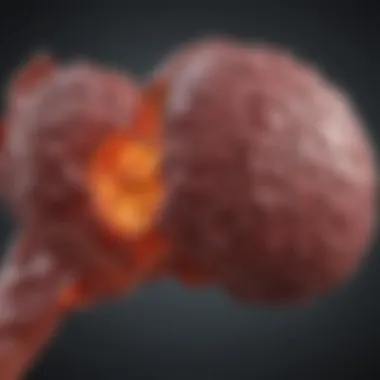
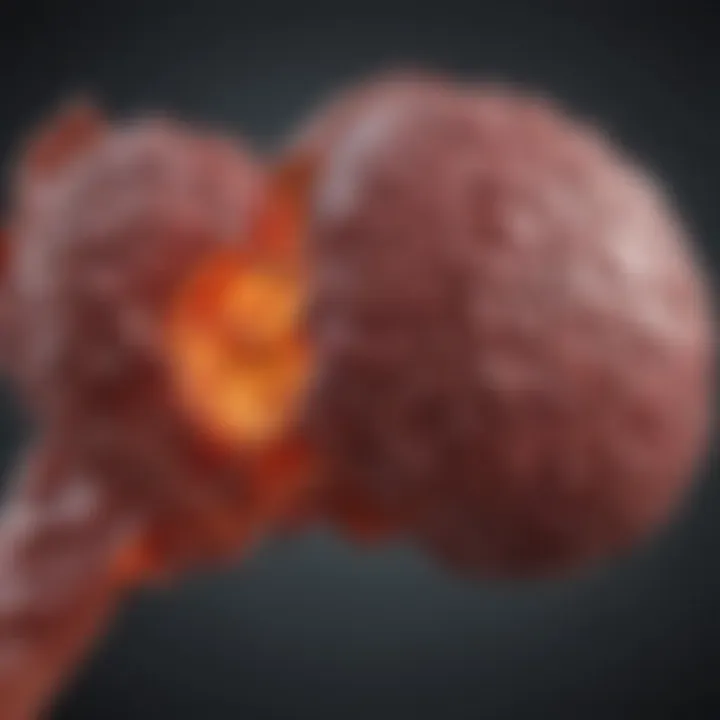
In summary, a multifaceted understanding of liver cancer risk factors provides a foundational approach to prevention and early detection efforts. Recognizing these risks can catalyze meaningful changes in public health policies, focusing on education and accessibility of healthcare services.
In summary, a multifaceted understanding of liver cancer risk factors provides a foundational approach to prevention and early detection efforts. Recognizing these risks can catalyze meaningful changes in public health policies, focusing on education and accessibility of healthcare services.
By addressing these various factors, we can foster a proactive approach to liver cancer, enhancing screening programs and improving patient outcomes.
Molecular Pathogenesis of Liver Cancer
Understanding the molecular pathogenesis of liver cancer is integral to grasping how this disease develops and progresses. This area emphasizes the underlying biological mechanisms that drive liver cancer, including different genetic and epigenetic factors. Knowledge about these aspects can lead to improved diagnostic methods and targeted therapeutic approaches.
Genetic Alterations and Mutations
Genetic alterations play a vital role in the development of liver cancer, particularly hepatocellular carcinoma. Mutations in genes such as TP53, CTNNB1, and KRAS are commonly observed in liver cancer cases. These mutations can disrupt normal cellular functions, leading to unregulated cell growth.
- TP53 mutation: Affects the tumor suppressor gene, increasing the risk of malignant transformation.
- CTNNB1 mutation: Linked to the Wnt signaling pathway, which contributes to tumor growth and progression.
- KRAS mutation: Often implicated in the development of various cancers and can influence treatment outcomes.
By analyzing these mutations, researchers can better understand how liver cancer arises and develops. This knowledge is crucial for designing personalized treatment strategies.
Epigenetic Changes
Epigenetic changes refer to modifications that affect gene expression without altering the DNA sequence. These changes can be as impactful as genetic mutations in the context of liver cancer.
- DNA methylation: Hypermethylation of tumor suppressor genes can result in their silencing, promoting cancer progression.
- Histone modification: Alterations in histones can influence chromatin structure and gene accessibility, further contributing to tumorigenesis.
Understanding these changes offers insights into the mechanisms of liver cancer and highlights potential targets for intervention. It serves as a reminder that cancer is not only driven by inherited genetic mutations but also influenced by epigenetic factors, creating a complex interplay in cancer development.
Tumor Microenvironment
The tumor microenvironment is a crucial factor in liver cancer progression. This environment consists of not only cancer cells but also surrounding non-malignant cells, extracellular matrix components, and signaling molecules. The interaction between tumor cells and their microenvironment can significantly influence cancer behavior.
- Inflammation: Chronic inflammation, associated with conditions like cirrhosis, can foster an environment that promotes tumor growth.
- Fibroblasts and immune cells: Cellular components can either inhibit or support tumor development, depending on their activation state and secreted factors.
- Vascularization: Tumors require blood supply for growth. The interactions within the tumor microenvironment contribute to angiogenesis, which supports tumor metabolic needs.
In summary, the molecular pathogenesis of liver cancer unveils the complex interactions and pathways that drive this disease. A deeper understanding of genetic alterations, epigenetic changes, and the tumor microenvironment is crucial for developing innovative diagnostic and therapeutic strategies. This multifaceted approach not only enhances our comprehension of liver cancer but also paves the way for more effective treatment modalities.
Clinical Presentation and Symptoms
Understanding the clinical presentation and symptoms of liver cancer is vital for timely diagnosis and treatment. Many patients experience vague symptoms initially, leading to delays in detecting the disease. Identifying these early and late-stage manifestations can significantly influence treatment outcomes and the overall prognosis for affected individuals.
Early Symptoms and Late-Stage Manifestations
Early symptoms of liver cancer may be subtle and non-specific. Patients often report fatigue, general malaise, and weight loss. A common early sign is abdominal discomfort or pain, which can be mistaken for other gastrointestinal issues. Additionally, the presence of jaundice—characterized by yellowing of the skin and eyes—can occur, indicating a more advanced disease stage.
- In the initial phases, liver cancer may also cause:
- Loss of appetite
- Nausea and vomiting
- Swelling in the abdomen due to fluid accumulation (ascites)
As the disease progresses, symptoms tend to become more pronounced. Late-stage liver cancer often manifests with severe abdominal pain, significant weight loss, and increased fatigue. Patients may also experience complications associated with liver dysfunction, such as coagulopathy, which can result in easy bruising or bleeding.
"Early recognition of liver cancer symptoms is vital as it can alter the course of treatment and improve patient survival rates."
"Early recognition of liver cancer symptoms is vital as it can alter the course of treatment and improve patient survival rates."
Diagnostic Challenges
Clinical presentation plays a crucial role in the diagnostic process for liver cancer. However, diagnosing liver cancer remains challenging due to the non-specific nature of early symptoms. Health care providers may initially misdiagnose liver cancer as other conditions. In some cases, patients with chronic liver disease may have symptoms that obscure the diagnosis of malignancy.
The overlap with conditions like cirrhosis and hepatitis makes distinguishing liver cancer complex. Moreover, not all patients exhibit significant symptoms until the disease has reached an advanced stage. This lack of early warning signs contributes significantly to the poor prognosis associated with liver cancer.
- Key challenges include:
- Differentiating between liver cancer and other liver conditions
- Late presentation of symptoms in patients
- Limited awareness and knowledge regarding early signs among patients and some health professionals
Consequently, awareness and education about liver cancer's clinical presentation are essential for improving diagnosis rates and ensuring patients receive the correct treatment in due time.
Diagnostic Approaches for Liver Cancer
The diagnosis of liver cancer is a complex but vital process. It significantly impacts treatment decisions, potential outcomes, and overall patient care. Understanding the correct diagnostic approaches is crucial in identifying the disease early, especially since the prognosis for liver cancer can heavily depend on its stage at diagnosis.
Timely and accurate diagnosis guides necessary interventions and helps to tailor treatment modalities effectively. With advancements in technology and research, several methods are available today to diagnose liver cancer skillfully. Each approach has its benefits and limitations that warrant careful consideration.
Imaging Techniques
Imaging plays a central role in liver cancer diagnosis. It assists clinicians in visualizing liver anatomy and detecting abnormal masses. Common modalities include:
- Ultrasound: This is often the first imaging test performed. It is non-invasive and uses sound waves to create images of the liver, enabling initial assessment of liver lesions.
- Computed Tomography (CT) Scan: CT scans provide detailed cross-sectional images of the liver. They help in characterizing tumors and assessing their size and location.
- Magnetic Resonance Imaging (MRI): MRI offers high-resolution images and is particularly useful in detecting small lesions or assessing vascular involvement.
These imaging techniques help distinguish between hepatocellular carcinoma and other types of liver masses. Accurate imaging allows for a more informed treatment strategy suited to the individual patient's condition.
Biomarkers and Blood Tests
Biomarkers can play a complementary role in diagnosing liver cancer. Specific blood tests help in assessing liver function and detecting cancer indicators:
- Alpha-fetoprotein (AFP): AFP levels can be elevated in patients with hepatocellular carcinoma. A higher concentration may indicate the presence of liver cancer.
- Liver Function Tests (LFTs): These tests evaluate overall liver health and function, assisting in making diagnoses and determining the impact of the disease on liver function.
While biomarkers can suggest the possibility of cancer, they are not definitive diagnostic tools. They should be used in conjunction with imaging findings and clinical evaluation for the most effective diagnosis.
Histopathological Examination
Histopathological examination remains the gold standard for liver cancer diagnosis. A biopsy may be conducted to extract tissue samples for microscopic analysis. This examination can determine whether cancer is present and its specific type. Here’s what encompasses this approach:
- Needle Biopsy: In this process, a thin needle is inserted into the liver to extract tissue. This can be guided by ultrasound or CT imaging to ensure precision.
- Surgical Biopsy: In certain cases, a more extensive surgical procedure may be necessary to obtain a definitive diagnosis.
Histopathological findings provide valuable information about the tumor's grade and potential behavior, influencing treatment choices. This approach is particularly critical when imaging and blood tests yield ambiguous results.
The integration of imaging, biomarker analysis, and histopathological examination establishes a comprehensive framework for diagnosing liver cancer effectively.
The integration of imaging, biomarker analysis, and histopathological examination establishes a comprehensive framework for diagnosing liver cancer effectively.
Staging of Liver Cancer
Staging of liver cancer is a significant aspect in understanding the progression of the disease, directing treatment options, and predicting the prognosis. Accurate staging allows for tailored therapy and helps clinicians make informed decisions regarding management strategies. It also provides a common language among healthcare providers, facilitating multidisciplinary collaboration.
The staging process evaluates several factors, including tumor size, location, lymph node involvement, and presence of metastasis. Properly categorizing liver cancer is crucial because it impacts both treatment approaches and the extent of care needed subsequently. Knowledge of staging can help in recognizing how liver cancer behaves in individual patients and assigning them to appropriate clinical trials or therapeutic protocols.
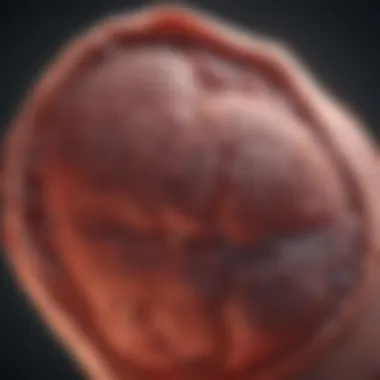
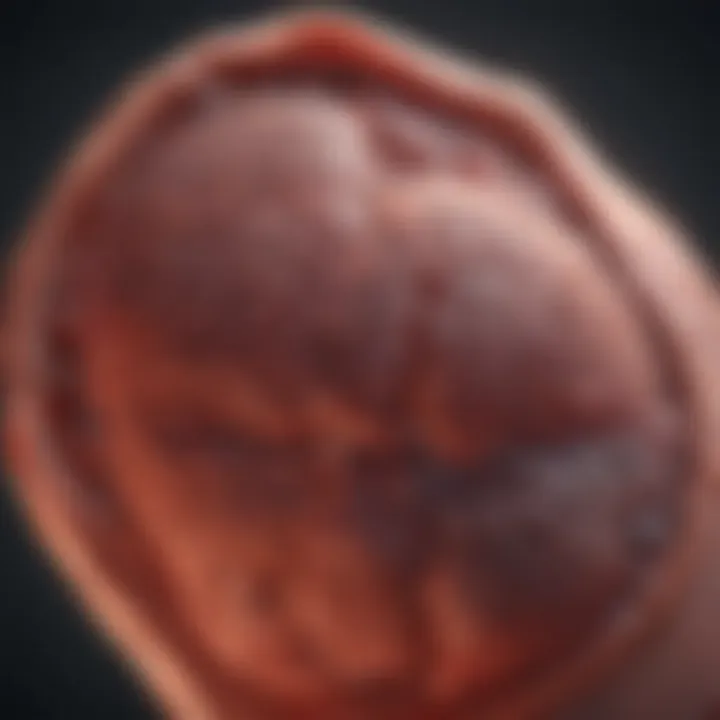
Moreover, understanding the stage of liver cancer is vital for patients and their families. It clarifies the nature of the disease, helping them to make educated choices regarding their care plan. Furthermore, some treatments may vary not only based on the type of liver cancer but also according to its stage.
"Accurate staging is crucial for effective treatment of liver cancer. It drives clinical choices and influences outcomes."
"Accurate staging is crucial for effective treatment of liver cancer. It drives clinical choices and influences outcomes."
TNM Classification System
The TNM classification system is one of the most widely utilized tools for staging liver cancer, providing a clear framework for evaluating the cancer's extent. The acronym TNM stands for Tumor, Nodes, and Metastasis, and each component offers distinct information:
- T (Tumor): This describes the size of the primary tumor and whether it has invaded nearby structures. For liver cancer, T is further classified from 0 to 4, depending on the tumor size and proximity to surrounding tissues.
- N (Nodes): This element assesses whether cancer has spread to regional lymph nodes. Ranging from N0 (no involvement) to N3 (extensive involvement), this classification helps gauge nodal metastasis.
- M (Metastasis): This indicates whether there are distant metastases to other organs. M0 indicates no distant spread, while M1 signifies the presence of metastasis.
The TNM classification aids in determining the stage of cancer, from Stage I (localized disease) to Stage IV (advanced disease). This systematic approach allows for more personalized treatment respons equ to the specific characteristics of the tumor and the individual's health status.
Barcelona Clinic Liver Cancer Staging
The Barcelona Clinic Liver Cancer (BCLC) staging system focuses on hepatocellular carcinoma and incorporates various factors, emphasizing the prognosis and treatment recommendations. It integrates not only tumor characteristics but also the liver function and the patient's performance status, thereby offering a comprehensive view.
Key components of BCLC staging include:
- Clinical Stage: This reflects the severity based on the tumor's size, vascular invasion, and extrahepatic spread.
- Liver Function: The Child-Pugh score measures liver function, categorizing patients into different classes (A, B, or C) based on bilirubin levels, albumin levels, prothrombin time, and the presence of ascites or encephalopathy.
- Performance Status: The Eastern Cooperative Oncology Group (ECOG) scale evaluates how cancer affects a person's ability to perform daily activities.
BCLC considers these aspects together to establish a treatment plan that may include surgical options, locoregional therapies, or systemic therapies. The simplicity of the BCLC system offers guidance on standard treatment pathways and helps healthcare providers communicate effectively with patients about their options.
In summary, both the TNM Classification and BCLC Staging systems play crucial roles in the management of liver cancer. They provide essential frameworks for assessing the disease's extent and guide treatment decisions tailored to individual patient needs.
Treatment Options for Liver Cancer
The treatment options for liver cancer are paramount as they directly influence patient outcomes, symptom management, and quality of life. This section explores various treatment modalities, including surgical interventions, medical therapies, radiation options, and advanced targeted therapies. By understanding these options, health professionals can tailor approaches specific to each patient's needs, maximize effectiveness, and improve prognosis.
Surgical Interventions
Surgical intervention remains a first-line treatment for liver cancer, particularly for localized cases. The most common surgical procedure is a partial hepatectomy, where a section of the liver containing tumors is removed. Alternatively, liver transplantation is an option for select patients, especially those with severe cirrhosis or multifocal disease.
- Benefits:
- Considerations:
- Potentially a curative approach for eligible patients.
- Removal of cancerous tissue may alleviate symptoms and prevent progression.
- Not suitable for all patients, particularly those with advanced disease.
- Post-operative complications and recovery time must be taken into account.
"Surgery can provide a critical opportunity for long-term survival in liver cancer patients, warranting thorough evaluation by a specialized team."
"Surgery can provide a critical opportunity for long-term survival in liver cancer patients, warranting thorough evaluation by a specialized team."
Medical Therapies
Medical therapies encompass a range of treatments aimed at targeting cancer cells through various mechanisms. Systemic therapies include chemotherapy agents and hormonal therapies to treat advanced liver cancer when surgery is not an option.
- Chemotherapy:
- Targeted Therapy:
- Typically used for cancers with significant spread but has limited effectiveness on liver cancers, especially HCC.
- Common regimens may include drugs like doxorubicin or cisplatin.
- Involves drugs such as Sorafenib and Lenvatinib, effective in prolonging survival in advanced stages.
- Target specific pathways involved in cancer cell proliferation.
Radiation and Locoregional Therapies
Radiation therapies can be administered for both curative and palliative purposes. They can shrink tumors or control pain related to advanced disease. There are different radiation approaches:
- External Beam Radiation Therapy (EBRT):
- Radiofrequency Ablation (RFA):
- Involves targeting the tumor from outside the body with high-energy beams.
- Can be effective for tumor control.
- This locoregional therapy uses heat to destroy cancer cells.
- Minimally invasive and can be performed on fibrous tumors, making it suitable for small tumors.
Targeted Therapies and Immunotherapy
Recent advancements have brought new hope in liver cancer treatment through targeted therapies and immunotherapy. These modalities aim to enhance the immune system's ability to fight cancer and to inhibit cancer-specific pathways.
- Targeted Therapies:
- Immunotherapy:
- Focus on genetic mutations and specific characteristics of the tumor.
- Drugs like Regorafenib are making a difference in advanced HCC.
- Checkpoint inhibitors such as Nivolumab and Pembrolizumab help activate the immune response against cancer.
- May benefit patients with advanced liver cancer and show promising results in ongoing clinical trials.
Post-Treatment Considerations
Post-treatment considerations are critical in the management of liver cancer. After the primary phase of treatment, which may involve surgery, chemotherapy, or radiation, it is essential to continue monitoring the patient. The importance of this phase cannot be understated. It allows healthcare providers to identify any signs of recurrence early and manage complications that may arise from treatment.
Surveillance for Recurrence
Surveillance for recurrence is a paramount aspect of post-treatment care. Studies show that regular monitoring can lead to early detection of cancer recurrence, significantly influencing prognosis. After treatment, patients typically undergo a structured follow-up schedule, often every three to six months during the first two years, and then annually for the following years.
Common methods of surveillance include:
- Imaging Techniques: Computed tomography (CT) scans and magnetic resonance imaging (MRI) are standard methods for detecting recurrence.
- Blood Tests: Measurement of tumor markers, particularly alpha-fetoprotein (AFP), can provide insights into the patient’s condition.
Timely intervention is essential. If recurrence is detected early, treatment options may include repeat surgery or targeted therapies, which can substantially improve outcomes.
Management of Complications
Management of complications post-treatment also forms a significant part of the care plan. Liver cancer treatments, while effective, come with their own set of challenges.
Complications can include:
- Liver Dysfunction: Some patients may experience impaired liver function due to tumor burden or treatment effects. Regular liver function tests are vital in assessing the organ's health.
- Infections: Patients are at increased risk for infections, especially following surgical interventions. Prophylactic measures and prompt management of infections are crucial.
- Pain Management: Chronic pain can be an issue for many patients. Effective pain management strategies should be instituted early, tailored to individual needs.
Advances in Research and Clinical Trials
Advancements in research and clinical trials are crucial for enhancing our understanding and treatment of liver cancer. This aspect plays an integral role in developing innovative therapies and refining existing treatment modalities. Understanding the trends and findings in this field is essential for improving patient outcomes and informing clinical practices.
Recent studies have brought forth emerging therapies, which reflect a significant shift in how liver cancer is approached medically. These new treatments not only offer hope but also provide alternative options to conventional therapies. Therefore, their importance cannot be overstated.
Emerging Therapies

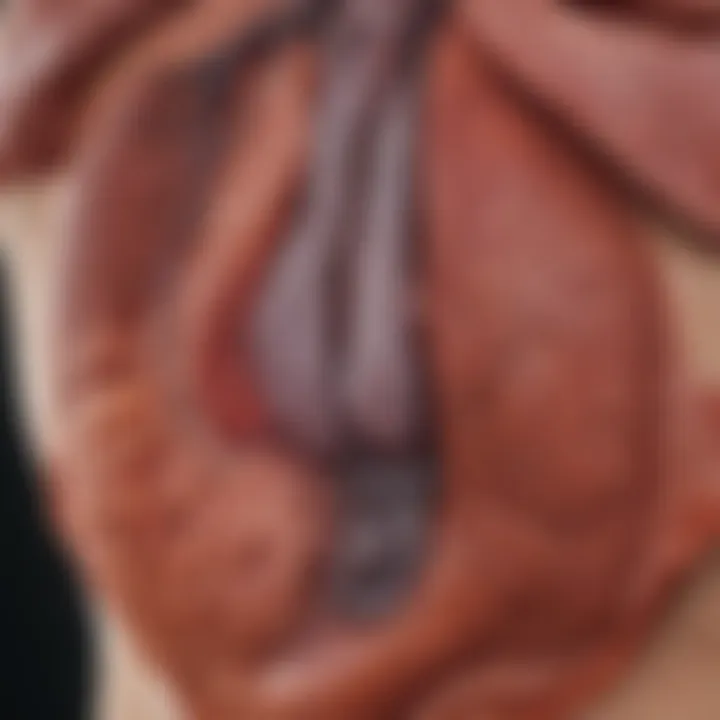
Emerging therapies for liver cancer include a variety of new drugs and techniques that show promise in treating the disease more effectively. These therapies may target cancer cells specifically or enhance the body’s immune response against tumors. Notable examples include:
- Novel Immunotherapies: These therapies harness the body's immune system to recognize and attack liver cancer cells, showcasing better long-term outcomes for some patients.
- Targeted Therapies: Drugs such as Sorafenib and Lenvatinib target specific pathways involved in tumor growth, offering a treatment designed to disrupt the cancer's development.
- Combination Treatments: Combining traditional chemotherapy with newer agents can enhance the efficacy of treatment and minimize side effects compared to standard treatments alone.
The ongoing exploration of these therapies is pivotal. Clinical trials serve as a necessary vehicle for validating their effectiveness and safety. As new data emerges, it allows researchers to refine treatments and develop personalized approaches to patient care.
Genomic Profiling in Trials
Genomic profiling plays an essential role in modern clinical trials for liver cancer. This process involves examining the genetic alterations present in the tumor cells. It can identify mutations that may be targeted by specific therapies, leading to more tailored treatment options. Some key points regarding genomic profiling include:
- Identification of Biomarkers: Genomic profiling can reveal biomarkers that indicate how a tumor might respond to certain treatments, paving the way for personalized medicine.
- Exploration of Drug Resistance: Understanding genetic alterations can help researchers understand the mechanisms behind drug resistance, allowing for the development of strategies to overcome it.
- Improved Patient Stratification: Patients can be better grouped based on their tumor genetics, ensuring that the right treatments are provided to the most appropriate candidates, leading to improved outcomes.
Genomic profiling is changing the landscape of liver cancer treatment, offering insights that sometimes lead to surprising findings and revisions in treatment protocols.
Genomic profiling is changing the landscape of liver cancer treatment, offering insights that sometimes lead to surprising findings and revisions in treatment protocols.
Overall, the advances in research and clinical trials for liver cancer signify a hopeful future. Continuous investigation into emerging therapies and the role of genomic profiling can provide further insights, enhancing clinical outcomes and paving the way for more personalized approaches to care. The combination of these strategies paints a more optimistic picture not just for oncologists but also for patients facing liver cancer.
Quality of Life and Supportive Care
Quality of life (QoL) plays a pivotal role in the management of liver cancer. This aspect goes beyond curative treatment and addresses the comprehensive needs of patients regarding physical, emotional, and social well-being. Understanding and improving QoL is essential, not only for the patients but also for their families and healthcare providers. A multifaceted approach can enhance the patient's ability to cope with the disease and its treatments, ultimately influencing outcomes and overall satisfaction.
Effective support and care strategies can lead to better management of symptoms, more effective communication with healthcare providers, and improved adherence to treatments. This section will explore palliative care approaches and psychosocial support mechanisms tailored for liver cancer patients, highlighting their significance in enhancing QoL.
Palliative Care Approaches
Palliative care in liver cancer focuses on alleviating symptoms and improving the patient's quality of life, irrespective of the stage of the disease or the ongoing treatments. It aims to provide relief from distressing symptoms such as pain, nausea, fatigue, and psychological distress.
Key aspects of palliative care include:
- Symptom Management: Control of physical symptoms is crucial. Medications, physical therapy, and complementary therapies may be used to ease pain and discomfort.
- Interdisciplinary Team: A team approach combines specialists from various fields—doctors, nurses, social workers, and nutritionists—to provide comprehensive care tailored to the patient's needs.
- Advance Care Planning: Encouraging discussions about future goals, values, and preferences for care can help align treatments with patients’ wishes, reducing anxiety and increasing satisfaction.
Palliative care is beneficial at any stage of liver cancer, and it does not mean giving up on curative treatment. Rather, it complements it by prioritizing patient comfort.
Psychosocial Support Mechanisms
Supportive care for liver cancer patients effectively encompasses not only physical needs but also mental and emotional support. Psychosocial challenges, including anxiety and depression, are common among patients, and recognizing these can lead to better outcomes.
Important psychosocial support mechanisms include:
- Counseling Services: Professional support can help patients deal with their feelings about diagnosis, treatment, and future outcomes. Individual therapy or support groups can foster a sense of community and understanding.
- Family Support: It is critical to engage families in the care process. They should be educated about the disease and treatment options, enabling them to provide informed support.
- Social Activities: Encouraging social interactions can combat isolation, providing a sense of belonging and unplugging from the disease-related stress. Activities may include group therapy sessions, leisure clubs, or community resources.
By fostering both physical and emotional well-being through these support mechanisms, liver cancer patients can achieve an enhanced quality of life.
"Quality of life is an important indicator of the success of care in patients with liver cancer."
"Quality of life is an important indicator of the success of care in patients with liver cancer."
Ethical Considerations in Liver Cancer Treatment
The ethical considerations surrounding liver cancer treatment are crucial for ensuring that patients receive care that respects their rights and well-being. As treatments evolve, the need for ethical frameworks becomes more apparent. This section explores essential elements such as informed consent and patient autonomy, along with resource allocation in treatment options. These considerations highlight healthcare's moral dimensions, ultimately shaping how patients navigate their treatment pathways.
Informed Consent and Patient Autonomy
Informed consent is a fundamental principle in medical ethics, especially in hepatology and oncology. It requires that patients are fully aware of the benefits and risks associated with various treatments. Patients diagnosed with liver cancer face numerous treatment options, such as surgical resection, ablation, and systemic therapies. Each carries distinct risks and benefits that can significantly affect outcomes and quality of life.
To uphold patient autonomy, healthcare professionals must provide comprehensive information to the patient. This encompasses not only medical details but also the potential impact on daily life, family, and psychosocial aspects. A well-informed patient can make choices that align with their values and preferences. Conversely, if patients are left uninformed, they may make decisions that do not reflect their true desires.
Healthcare providers must also be sensitive to varying levels of health literacy. Tailoring explanations to meet the patient’s understanding capabilities is vital. A written document outlining key treatment options and their implications can support discussions. Therefore, careful communication fosters trust and empowers patients to participate actively in their own care decisions.
Resource Allocation in Treatment Options
Resource allocation poses another ethical dilemma in liver cancer treatment. With limited healthcare resources, decisions regarding treatment funding and availability can impact patient outcomes and access to care. Different therapies may vary in cost, efficacy, and accessibility based on hospital resources or geographic location.
Health systems face challenges in deciding which treatments to prioritize. The following factors are often taken into account:
- Effectiveness: The clinical benefit of a treatment option in increasing survival or improving quality of life.
- Cost-effectiveness: Analyzing if the benefits justify the costs associated with a particular treatment.
- Equity in access: Ensuring all patients, regardless of their socioeconomic status, can access the necessary treatments.
An ethical framework for resource allocation should balance clinical effectiveness and equity, promoting fairness in care distribution. It becomes essential to involve stakeholders—including healthcare providers, patients, and policymakers—in discussions about treatment options.
"Ethical considerations in treatment extend beyond medical efficacy. They also encompass the dignity and autonomy of the patient."
"Ethical considerations in treatment extend beyond medical efficacy. They also encompass the dignity and autonomy of the patient."
Ending
In concluding this comprehensive examination of liver cancer, we reflect on the overarching significance of understanding this complex disease. The meticulous exploration of pathophysiology, risk factors, and treatment modalities has underscored the importance of each aspect in shaping effective management strategies for patients afflicted with hepatocellular carcinoma and cholangiocarcinoma. Through this synthesis, the article aims to provide valuable insights for a diverse audience, including students, researchers, and healthcare professionals.
Summary of Key Findings
Key findings emerge from the detailed discussion throughout the article:
- Epidemiology: Liver cancer exhibits significant geographic and demographic variations, with higher prevalence in regions such as East Asia and Sub-Saharan Africa.
- Molecular Insights: Genetic mutations and epigenetic changes play a crucial role in the development of liver cancer, indicating potential targets for future therapies.
- Diagnostic Techniques: Enhanced imaging modalities and biomarkers have improved diagnostic accuracy, yet challenges in early detection persist.
- Treatment Advances: A combination of surgical, medical, and locoregional therapies provides a multifaceted approach, highlighting the need for personalized treatment plans tailored to individual patient profiles.
The overall implication of these findings connects to the necessity of ongoing research in liver cancer to improve patient outcomes, increase survival rates, and reduce the global burden of this disease.
Future Directions in Liver Cancer Research
Future directions in liver cancer research promise to advance our understanding and treatment approaches. Significant areas of focus include:
- Genomics: Continued exploration of genomic profiling will facilitate the identification of biomarkers that predict treatment response and disease progression.
- Novel Therapeutics: The investigation of combination therapies, especially those integrating targeted therapies and immunotherapies, may yield more effective treatment options.
- Public Health Strategies: Understanding the socioeconomic and environmental factors contributing to liver cancer can lead to more effective prevention strategies.
- Clinical Trials: Ongoing and new clinical trials are essential for evaluating the efficacy of emerging treatment options and ensuring that patients have access to innovative therapies.
Ultimately, addressing these areas in liver cancer research is vital not only for enhancing therapeutic outcomes but also for improving the quality of life for patients. Engaging with these elements is crucial for medical communities and stakeholders aiming to combat the complexities surrounding liver cancer better.
Importance of References
When discussing medical topics, precise referencing is foundational. Here are some key reasons why references are essential in this article:
- Evidence of Research Integrity: References demonstrate that the content is derived from scientific studies, reputable journals, and authoritative sources. This helps to build trust with the readership.
- Understanding Context: Thorough bibliographies allow readers to delve deeper into specific areas of interest. This can lead to better understanding of complex topics such as the pathophysiology and treatment methodologies of liver cancer.
- Facilitating Further Learning: Providing aditional resources empowers readers to explore the subject beyond the article. This encourages continued education on the topic and fosters an informed community.
Considerations Regarding References
While compiling references, it is important to ensure that:
- Sources are up-to-date, particularly in a field that evolves rapidly, such as oncology.
- A balance is maintained between primary research articles and comprehensive review papers to cover both specific findings and broad overviews.
- References are drawn from a variety of reputable sources, including open-access journals, which can enhance accessibility for all readers.
"Accurate references not only strengthen an article's credibility but also provide pathways for readers to acquire additional information and ongoing insights."
"Accurate references not only strengthen an article's credibility but also provide pathways for readers to acquire additional information and ongoing insights."



